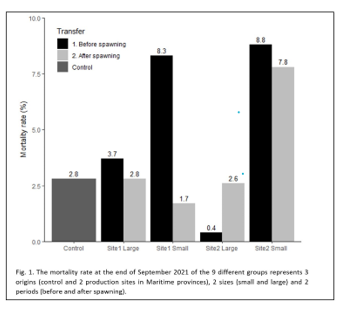ANALYSIS OF STRESS ASSOCIATED TO INTER-SITES TRANSPORT ON THE AMERICAN OYSTER PRODUCTION
The American oyster (Crassostrea virginica) benefits a value-added and well-established market in Canada. In Québec, most of the production is realized in the Magdalen Islands. The environmental conditions associated with climate change, particularly the warmer seawater observed in the lagoons stimulate the production of this tolerant species. The northern limit distribution of American oysters is observed in the Gulf of St. Lawrence in New Brunswick (47°N) explaining the natural absence of this species in Magdalen Islands. Thus, the production is supported by importation from the Maritime provinces since 2012, as natural reproduction does not support important recruitment success and spat collection in Magdalen Islands. However, since the start of this activity, episodes of mortality have been observed in the year following the transfer. This mortality seem not associated with pathogens, as no disease has been identified. We suggest that mortality is associated to transport and we try to develop physiological tools to quantify stress levels submitted for the development of best management practices.
Before and after spawning events in 2021, we received 300 large-sized oysters and 300 small-sized oysters from two production sites in Maritime provinces related to different transport distance. We used oysters implanted in Magdalen Island for two years after their interprovincial transfer as control. Thus, 9 oysters’ groups constituted for 3 origins (control and 2 production sites), 2 sizes (small and large) and 2 periods (before and after spawning) were compared. To characterize the oyster condition and estimate their vitality level, different physiological indicators were used. Valvometry (the continuous measurement of the opening and closing valves), condition index and the level of resistance to air exposure were tested to estimate their vitality. Direct physiological measures of oxygen consumption and filtration rates were estimated, as well as the global accumulation of energy reserves (glycogen, lipids, and proteins) to assess their bioenergetic status and susceptibility to stress. All these indicators were related to the growth rate and mortality of each oyster groups from the beginning of the transfer until the end of the first wintering. Mortality and growth differences between oyster groups were observed with values from 0.4 to 8.8% mortality before the winter and growth twice more important in some groups. All this variability will be presented in relation to the viability and energetic status of oysters group following interprovincial transport.
